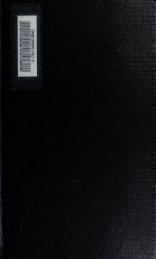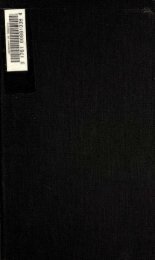Texts from the Buddhist canon : commonly known as Dhammapada
Texts from the Buddhist canon : commonly known as Dhammapada
Texts from the Buddhist canon : commonly known as Dhammapada
Create successful ePaper yourself
Turn your PDF publications into a flip-book with our unique Google optimized e-Paper software.
INTRODUCTION. 5<br />
" Not to commit any sin, to do good, and to purify one's<br />
mind, this is <strong>the</strong> teaching of <strong>the</strong> Awakened ;<br />
" <strong>the</strong> Chinese<br />
is, " Practising no evil way, advancing in <strong>the</strong> exercise of<br />
virtue, purifying both mind and will, this is <strong>the</strong> doctrine<br />
of aU <strong>the</strong> Buddh<strong>as</strong>." Again, stanza 2 14 in <strong>the</strong> Pali is this,<br />
" From lust comes grief, <strong>from</strong> lust comes fear, he who is<br />
free <strong>from</strong> lust knows nei<strong>the</strong>r grief nor fear." This is<br />
evidently <strong>the</strong> same <strong>as</strong> <strong>the</strong> testimony of K§,syapa Buddha,<br />
" A man <strong>from</strong> lust engenders sorrow, and <strong>from</strong> sorrow<br />
guilty fear ; banish lust and <strong>the</strong>re will be no sorrow, and<br />
if no sorrow <strong>the</strong>n no guilty fear." {Catena, p. 200.)<br />
Without quoting fur<strong>the</strong>r at length, we will simply note a<br />
few o<strong>the</strong>r agreements, e.g., compare stanza 239 with Catena,<br />
p. 201, § 34; stanza 281 with <strong>the</strong> record of K§,syapa<br />
{Catena, 159); stanza 292 with p. 264 {op. cit.) ; stanza<br />
372 with p. 247 {op. cit.) ; and in many o<strong>the</strong>r c<strong>as</strong>es. But<br />
perhaps <strong>the</strong> most curious agreement is to be found in<br />
various stanz<strong>as</strong> which occur in <strong>the</strong> Chinese version of <strong>the</strong><br />
" Lank^vatara Sutra," which w<strong>as</strong> translated into Chinese<br />
by a priest Gunabhadra, early in <strong>the</strong> Sung dyn<strong>as</strong>ty {Cire.<br />
420 A.D.). Of <strong>the</strong>se I shall only select one <strong>as</strong> throwing<br />
some light on a difficult verse in <strong>the</strong> Pali ; I refer to vv.<br />
294, 295, which run thus: "A true Brahmaua, though he<br />
h<strong>as</strong> lolled fa<strong>the</strong>r and mo<strong>the</strong>r and two valiant kings,<br />
though he h<strong>as</strong> destroyed a kingdom with all its subjects,<br />
is free <strong>from</strong> guUt."<br />
"A true Brahmana, though he h<strong>as</strong> kiUed fa<strong>the</strong>r and<br />
mo<strong>the</strong>r and two holy kings, and even a fifth man, is free<br />
<strong>from</strong> guilt."<br />
With respect to <strong>the</strong>se verses, both Professor Max Miiller<br />
and Professor Childers are inclined to regard <strong>the</strong>m <strong>as</strong><br />
showing that a truly holy man who commits such sins <strong>as</strong><br />
those specified is never<strong>the</strong>less guiltless. But in <strong>the</strong> third<br />
book, p. 3, of. <strong>the</strong> " Lankavat^ra Sutra" we find <strong>the</strong> following<br />
exposition of this doctrine :— " At this time Mahamati<br />
Bodhisatwa addressed Buddha and said, ' According to <strong>the</strong>





